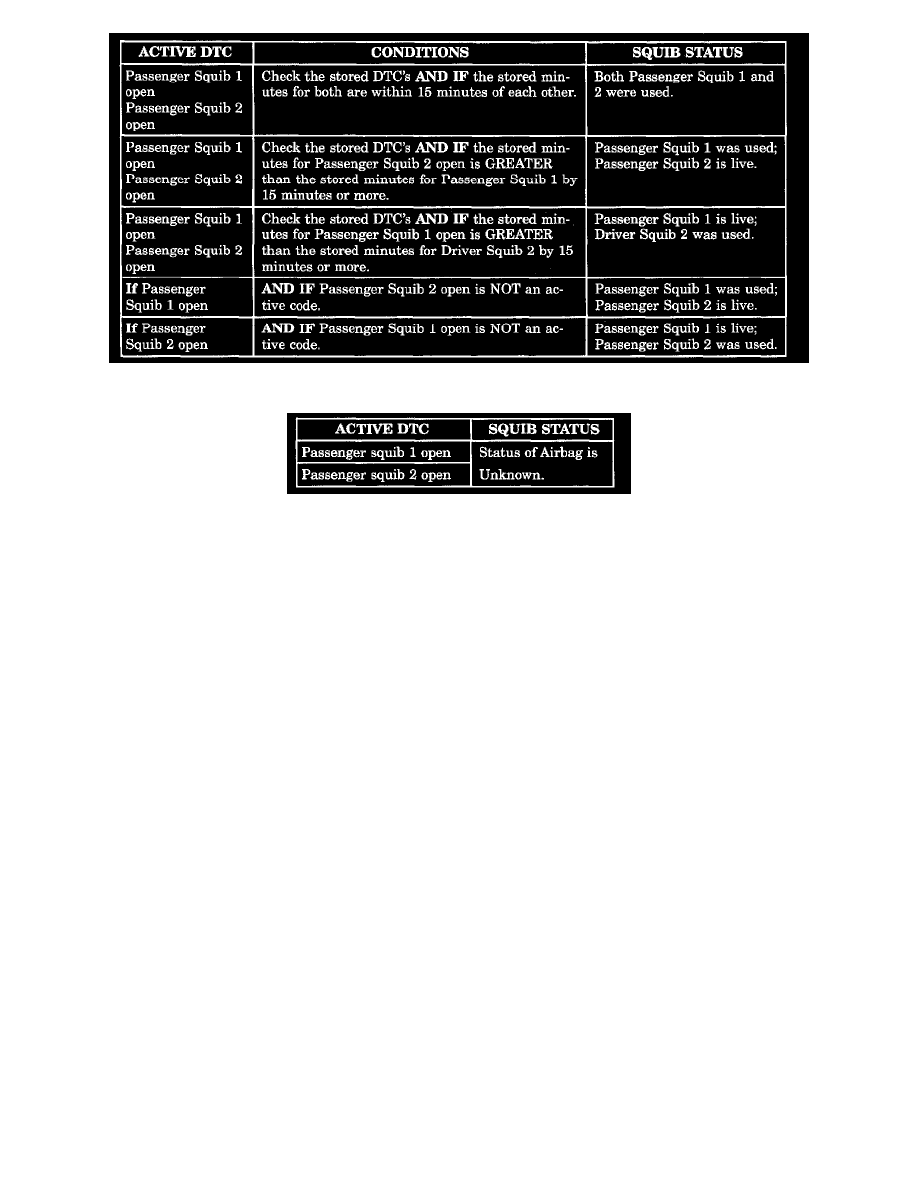Grand Cherokee 2WD V8-4.7L VIN J (2004)

1. Using a DRBIII(R) read Airbag DTC's. If the following active codes are present:
If neither of the following codes is an active code:
CAUTION: Deployed Front Air Bags may or may not have live pyrotechnic material within the air bag inflator. Do not dispose of 2004 Model Year
Driver and Passenger Airbags unless you are sure of complete deployment. Please refer to the Hazardous Substance Control System for Proper
Disposal. Dispose of deployed air bags in a manner consistent with state, provincial, local, and federal regulations. Use the following table to identify
the status of the Airbag Squib.
SEAT BELT SWITCHES (SBS)
The hall-effect driver seat belt switch provide the seat belt status, buckled or unbuckled, via hardwired inputs to the ACM. The ACM uses seat belt
Switch input to determine the appropriate level of airbag deployment. The ACM also controls the seat belt warning indicator via a PCI Bus message to
the instrument cluster. The indicator will be turned on if the driver seat belt status is unbuckled. If the seat belt switch is damaged or defective the seat
belt buckle assembly must be replaced. The ACM continuously monitors the seat belt switch circuits for an open or shorted conditions.
CURTAIN AIRBAGS
The Left and Right curtain airbags are located in the outboard edge of the roof under the headliner, just above the door openings. When supplied with
the proper electrical signal the inflator can discharge the compress gas directly into the curtain airbag. Upon deployment, the curtain will tear open the
headliner allowing the curtain airbag to fully deploy between the headliner and seat. The curtain airbag cannot re repaired and must be replaced if
deployed or in any way damaged.
WARNING: THE CURTAIN AIRBAG CONTAINS AN INERT GAS PRESSURIZED TO 17236.89 kPa (2500 PSI). DO NOT ATTEMPT
TO DISMANTLE AN AIRBAG MODULE OR TAMPER WITH ITS INFLATOR. DO NOT PUNCTURE, INCINERATE, OR BRING
INTO CONTACT WITH ELECTRICITY. DO NOT STORE AT TEMPERATURE EXCEEDING 93°C (200° F). REPLACE AIRBAG
SYSTEM COMPONENTS ONLY WITH PARTS SPECIFIED IN THE CHRYSLER MOPAR PARTS CATALOG. SUBSTITUTE PARTS
MAY APPEAR INTERCHANGEABLE, BUT INTERNAL DIFFERENCES MAY RESULT IN INFERIOR OCCUPANT PROTECTION.
THE FASTENERS, SCREWS, AND BOLTS ORIGINALLY USED FOR THE AIRBAG SYSTEM COMPONENTS HAVE SPECIAL
COATINGS AND ARE SPECIFICALLY DESIGNED FOR THE AIRBAG SYSTEM. THEY MUST NEVER BE REPLACED WITH ANY
SUBSTITUTES. ANY TIME A NEW FASTENER IS NEEDED, REPLACE IT WITH THE CORRECT FASTENERS PROVIDED IN THE
SERVICE PACKAGE OR SPECIFIED IN THE MOPAR PARTS CATALOG.
SEAT BELT TENSIONER
On some models the front seat belt systems incorporate Tensioner Modules. At the onset of an impact event each tensioner uses a pyrotechnic device,
which is triggered simultaneously with the airbags, to rapidly retract the seat belts. With the slack removed, the occupant's forward motion in an
impact will be reduced as will the likelihood of contacting interior components. After an impact that deploys the airbag, the seat belt tensioner
assembly must be replaced. The ACM module monitors the Seat Belt Tensioners circuit resistance and reports active and stored DTC's if any problem
is found. When servicing the Seat Belt Tensioners, follow all of the safety procedures in the service information.
FRONT IMPACT SENSOR
